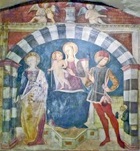


An inscription on the door of the cloister, which was recorded in the late 19th century but no longer survives, recorded that Aginaldo, Abbot of San Benedetto al Monte Subasio founded the church and adjacent priory in 1071. During the 12th century, the complex was known as San Paolo dell Abbadia in recognition of its continuing dependence on San Benedetto.
The church underwent successive transformations, and Pope Innocent IV re-consecrated it in 1253. The monks of San Benedetto came here in 1339 when their monastery was seriously damaged.
Canons of San Salvatore in Lauro in Rome, who were subordinate to the Venetian Congregazione di San Giorgio in Alga, owned the church from ca. 1481 until their suppression in 1652, when it passed to the canons of San Rufino. Much of the canonica was subsequently demolished.
The Confraternita di San Crispino met in the church from 1581 until 1790, and it now belongs to the Confraternita di San Rufino.
The church is only open occasionally (for example, on feasts of St Paul on 25th January and 29th June).
SS Paul, Benedict and Laurence Giustiniani (late 16th century)

[Laurence Giustiniani (1381-1455) was a Venetian nobleman who founded the Congregazione di San Giorgio in Alga. He became the patriarch of Venice in 1451 and was canonised in 1690].
Interior
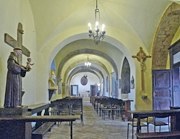
The interior is in the form of a single nave split by arches into seven bays.
[A Roman column forms part of the first arch to the left of the entrance.]
The third bay opens into a chapel to each side: the Cappella della Crocifisso and the Cappella della Madonna. The latter preserves part of the original fishbone paving.
The orientation of the church has been reversed: the high altar took on its current form only in 1981.
St Paul (ca. 1700)
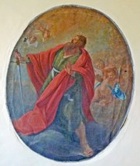
Cappella della Crocifisso
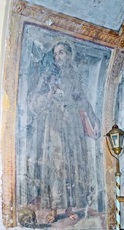

This chapel is on the left in the third bay of the nave. There are interesting frescoes to the sides, which depict:
-
✴St Francis (late 16th or early 17th century) on the left; and
-
✴St Antony Abbot (16th century) on the right.
Cappella della Madonna
This chapel on the preserves part of the original fishbone paving. The frescoes (late 16th century) depict:
-
✴the Madonna and Child with SS Crispin and Crispinian (the patron saints of shoemakers); and

-
✴SS Lucy (on the left) and Catherine of Alexandria.
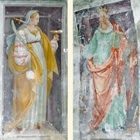
Processional Banners
The notes displayed in the church describe three banners that belong to the Confraternita di San Rufino, although only one of them was on display in the church during my visit in June 2009:
-
✴a double-sided banner (18th century) attributed to Antonio Maria Garbi with:
-
•SS Rufinus, Francis and Clare on one side; and
-
•the Deposition of Christ on the other;
-
✴a double-sided banner (1783) with:
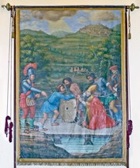
-
•the martyrdom of St Rufinus (illustrated here) on one side; and
-
•the translation of the relics of St Rufinus to Assisi on the other;
-
✴a double-sided banner (18th century) with:
-
•St Rufinus on one side; and
-
•SS Rufinus, Victorinus, Francis and Clare on the other.
Madonna and Child (1475)
